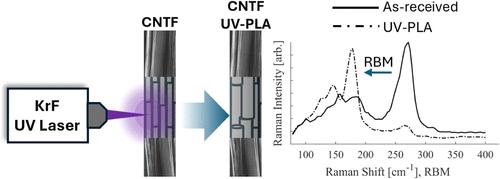CNT Coalescence within CNT Fibers via Ultraviolet Pulsed Laser Annealing
IF 3.2
3区 化学
Q2 CHEMISTRY, PHYSICAL
引用次数: 0
Abstract
Carbon nanotube fibers (CNTFs), composed of numerous aligned CNTs, show promise for a range of industries and applications based on the extraordinary thermal and electrical conductivities of individual CNTs. However, poor interfacial junctions between adjacent CNTs hinder phonon and electron transport, resulting in CNTFs with significantly lower conductivities than individual CNTs. Coalescing smaller-diameter CNTs into larger-diameter CNTs may create a more integrated network with reduced junction resistances, thereby improving interfacial junctions and, thus, transport properties. In this work, we employ ultraviolet pulsed laser annealing (UV-PLA) for targeted heating of CNTFs to induce coalescence. Raman spectroscopy is used to quantify CNT coalescence by analyzing radial breathing modes (RBMs), and the G- (graphitic) and D- (disordered) peaks. Our findings indicate that CNT coalescence can be induced within microseconds using UV-PLA. UV-PLA-coalesced CNTFs were shown to have exceptional thermal conductivities of up to 777 W/mK and electrical conductivities of up to 13.4 MS/m, after redoping.

紫外脉冲激光退火技术在碳纳米管纤维内的聚结
碳纳米管纤维(CNTFs)由许多排列整齐的碳纳米管组成,基于单个碳纳米管非凡的导热性和导电性,在一系列工业和应用中显示出前景。然而,相邻碳纳米管之间不良的界面连接阻碍了声子和电子的传递,导致碳纳米管的电导率明显低于单个碳纳米管。将小直径的碳纳米管聚结成大直径的碳纳米管可以形成一个更完整的网络,降低结电阻,从而改善界面结,从而改善传输性能。在这项工作中,我们采用紫外脉冲激光退火(UV-PLA)对cntf进行定向加热以诱导聚结。拉曼光谱通过分析径向呼吸模式(rbm)和G-(石墨)和D-(无序)峰来量化碳纳米管聚结。我们的研究结果表明,使用UV-PLA可以在微秒内诱导碳纳米管聚结。uv - pla聚结cntf在复染后具有高达777 W/mK的优异导热性和高达13.4 MS/m的导电性。
本文章由计算机程序翻译,如有差异,请以英文原文为准。
求助全文
约1分钟内获得全文
求助全文
来源期刊

The Journal of Physical Chemistry C
化学-材料科学:综合
CiteScore
6.50
自引率
8.10%
发文量
2047
审稿时长
1.8 months
期刊介绍:
The Journal of Physical Chemistry A/B/C is devoted to reporting new and original experimental and theoretical basic research of interest to physical chemists, biophysical chemists, and chemical physicists.
 求助内容:
求助内容: 应助结果提醒方式:
应助结果提醒方式:


